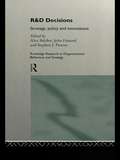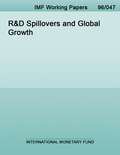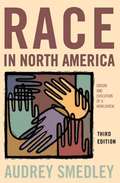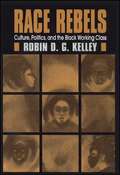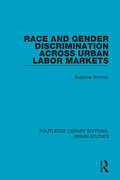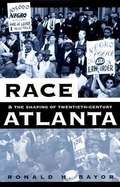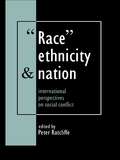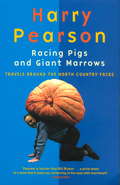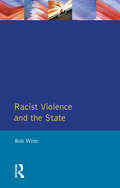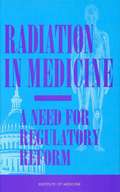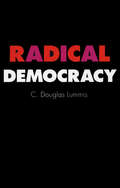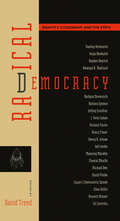- Table View
- List View
R&D Decisions: Strategy Policy and Innovations (Routledge Research in Strategic Management)
by John Hassard Alice Belcher Stephen J. ProcterR&D Decisions, Strategy, Policy and Innovations explores how research and development decisions affect all of us. They are linked inextricably to the performance of firms and of economics as a whole. Their importance means that they are of concern to a large number of practitioners, policy-makers and researchers. This book demonstrates the range of issues and perspectives which R&D can encompass and at the same time brings out the elements which unite them. The papers in this book are organized into three main sections: * Strategy and Organization explores the importance of R&D and of the structures and strategies of individual organizations. The emerging 'core competence paradigm' is especially noted. * Policy and Performance looks at what new thinking on R&D more generally implies for government policy and the performance of industries, regions and economies. * Disclosure and the Market examines issues raised by changing regulations on the disclosure of R&D expenditure.
R&D Spillovers and Global Growth (Imf Working Papers #No. 96/47)
by CoeA report from the International Monetary Fund.
R. S. Thomas: Everyman Poetry
by rev R.S. ThomasA best of R.S. Thomas's poems in a beautiful new gift editionR. S. Thomas (1913- 2000) was born in Cardiff. He studied classics, then theology and, after ordination, served six rural Welsh parishes for most of his life. His first book of poems was published in 1946. He won the Queen's Gold Medal for Poetry in 1964 and published regularly, Collected Poems 1945-90 marking his eightieth birthday.
R. S. Thomas: Everyman Poetry (Everyman Poetry Ser. #No. 7)
by Anthony Thwaite R. S. ThomasA best of R.S. Thomas's poems in a beautiful new gift editionR. S. Thomas (1913- 2000) was born in Cardiff. He studied classics, then theology and, after ordination, served six rural Welsh parishes for most of his life. His first book of poems was published in 1946. He won the Queen's Gold Medal for Poetry in 1964 and published regularly, Collected Poems 1945-90 marking his eightieth birthday.
R.R. Donnelley & Sons: The Digital Division
by David A. Garvin Artemis MarchIn June 1995, Barbara Schetter, VP and general manager of R.R. Donnelley's Digital Division, is struggling to gain acceptance from other groups and divisions at the printing giant. The Digital Division employs radically new technology--digital printing presses and transactions management systems--to deliver short-run, customized printing. But it is based on a completely different business model than Donnelley's traditional businesses and is finding it difficult to overcome informal resistance.
RHS Grow Your Own Veg & Fruit Bible
by Carol Klein'Featuring environmentally friendly methods for growing more than 75 fruits and vegetables, this is a must-have for gardening novices and pros alike, [...] One for the coffee table; it's as aspirational as it is practical.'Independent'Easy-to-follow practical advice on growing fruit, vegetables, salads and herbs throughout the year no matter how big or small your garden.'Gardens Illustrated'For those with rusty knowledge or who are just starting out on their kitchen garden journey, this detailed work, published in association with the RHS, is just what is required.'The English Garden'[An] easy-to-follow, practical and inspiring guide to growing produce all year round. Carol's environmentally friendly advice covers everything you need to succeed.'RHS The Garden MagazineHighly-regarded gardener Carol Klein has collaborated with the Royal Horticultural Society to create a lavishly illustrated, easy-to-follow, practical and inspiring beginner's guide to everything you need to know to grow fruit, vegetables, salads and herbs all year round.With an approach that is environmentally friendly and easy, Carol gives all the advice you need to succeed. Beginners and experienced gardeners alike will be inspired by this indispensable reference for every gardener's bookshelf.Whatever the size of the garden, this is a book to convert readers to the pleasures of growing and harvesting their own food. From preparing a plot, planning what to plant, and how to grow any one of the 80 featured food plants, this is a book to which growers can return every year, whatever their level of expertise. Key techniques are shown in step-by-step photography and there are invaluable illustrated directories of the best varieties to select for best results.With her usual energy and enthusiasm, Carol Klein offers green-fingered advice for growing all your appetizing favourites plus many less familiar crops also.The material is taken from the bestselling RHS Grow Your Own: Veg and RHS Grow Your Own: Fruit.
Race In North America: Origin and Evolution of a Worldview
by Audrey Smedley Brian SmedleyFew topics in the Western intellectual tradition have been subjected to as much scrutiny and analysis as the topic of race. This book examines the evolution of the concept. It shows that late-eighteenth-century North Americans came to believe that their society was composed of biologically exclusive and permanently unequal human groups, each with distinctive behavioral, moral, spiritual, and intellectual characteristics, led people to see biophysical and behavioral features as innate and immutable. In the nineteenth century, differences between whites, American Indians, and blacks were magnified in the popular mind and in scholarly writings to the point that these groups were seen as separate species, justifying the preservation of “racial” slavery and the subsequent dehumanization of freed blacks. With the application in the late nineteenth century of the racial worldview to European peoples and the subsequent twentieth-century inhumanity and brutality of Nazi race ideology, the concept of race came under attack. Liberal ideology coupled with advances in science prompted criticism of “race” and efforts to eliminate the term from the lexicon of science. In a sweeping work that traces the idea of race through three centuries of North American history, Audrey Smedley shows race to be a cultural construct used variously and opportunistically throughout time, although the scientific record shows little common agreement on its meaning. Tracing the social and historical processes that helped shape the idea of race, Smedley argues that race was and is a folk worldview, fabricated as an existential reality out of elements of English cultural history and the conquest and enslavement of physically distinct populations. The schism between science and popular thought on race, which appeared in the mid-twentieth century, continues today. If progressive scientists no longer accept the biological idea of race, will society eventually also reject it?The second edition expands its coverage of the nineteenth and twentieth centuries, particularly in matters of IQ testing and changing racial attitudes, including the contemporary movement aimed at identifying a “mixed race” category in the U. S. census. Smedley further examines the economic, social, and political factors after World War II that directly or indirectly affected the public’s thinking about race and discusses how the Civil Rights Movement and television during the 1950s and 1960s prompted greater attention to race and racism, causing many to rethink their beliefs and values. The first edition was named a 1994 Outstanding Book on Human Rights in North America by the Gustavus Myers Center.
Race In North America: Origin and Evolution of a Worldview
by Audrey Smedley Brian SmedleyThis sweeping work traces the idea of race for more than three centuries to show that "race” is not a product of science but a cultural invention that has been used variously and opportunistically since the eighteenth century. Updated throughout, the fourth edition of this renowned text includes a compelling new chapter on the health impacts of the racial worldview, as well as a thoroughly rewritten chapter that explores the election of Barack Obama and its implications for the meaning of race in America and the future of our racial ideology.
Race Rebels: Culture, Politics, and the Black Working Class
by Robin D. G. KelleyRobin D. G. Kelley is professor of history and Africana studies at New York University and author of Hammer and Hoe: Alabama Communists During the Great Depression (1990).
Race Traitor
by Noel Ignatiev John GarveyRace Traitor brings together voices ranging from tenured university professors to skinheads and prison inmates to discuss the "white question" in America. Working from the premise that the white race has been socially constructed, Race Traitor is a call for the disruption of white conformity and the formation of a New Abolitionism to dissolve it. In a time when white supremicist thinking seems to be gaining momentum, Race Traitor brings together voices ranging from tenured university professors to skinheads and prison inmates to discuss the "white question" in America. Through popular culture, current events, history and personal life stories, the essays analyze the forces that hold the white race together--and those that promise to tear it apart. When a critical mass of people come together who, though they look white, have ceased to act white, the white race will undergo fission and former whites will be able to take part in building a new human community.
Race and Gender Discrimination across Urban Labor Markets (Routledge Library Editions: Urban Studies #21)
by Susanne SchmitzThis study, first published in 1996, investigates the effects that local labor market conditions may have on the economic status of women and blacks, relative to their white male counterparts. More precisely, it examines the impact that local labor market conditions have on estimates of labor market discrimination investigated in this study are wage discrimination and occupational discrimination. This title will be of interest to students of sociology, gender studies and urban studies.
Race and the Shaping of Twentieth-Century Atlanta
by Ronald H. BayorAtlanta is often cited as a prime example of a progressive New South metropolis in which blacks and whites have forged "a city too busy to hate." But Ronald Bayor argues that the city continues to bear the indelible mark of racial bias. Offering the first comprehensive history of Atlanta race relations, he discusses the impact of race on the physical and institutional development of the city from the end of the Civil War through the mayorship of Andrew Young in the 1980s. Bayor shows the extent of inequality, investigates the gap between rhetoric and reality, and presents a fresh analysis of the legacy of segregation and race relations for the American urban environment. Bayor explores frequently ignored public policy issues through the lens of race--including hospital care, highway placement and development, police and fire services, schools, and park use, as well as housing patterns and employment. He finds that racial concerns profoundly shaped Atlanta, as they did other American cities. Drawing on oral interviews and written records, Bayor traces how Atlanta's black leaders and their community have responded to the impact of race on local urban development. By bringing long-term urban development into a discussion of race, Bayor provides an element missing in usual analyses of cities and race relations.
Race, Class and the Changing Division of Labour Under Apartheid
by Owen CrankshawAs the only comprehensive empirical analysis of the changing racial and occupational structure of the urban workforce in South Africa under apartheid, this study will make an invaluable contribution to our understanding of the complex inter-relations of past and present racial inequality and economic development in South Africa.
Race, Ethnicity And Nation: International Perspectives On Social Conflict
by Peter RatcliffeThis text offers an international and comparative analysis of social division rooted in race, ethnicity and national identity. It provides an overview of the key issues underlying ethnic conflict which has now risen to the top of the international political agenda.; This book is intended for academics, postgraduates and senior undergraduates within sociology, race and ethnicity, social anthropology, as well as those involved in other areas such as politics, geography, development studies and international relations with an interest in ethnicity.
Racing Pigs And Giant Marrows: Travels around the North Country Fairs
by Harry PearsonFollowing his acclaimed book about football in the north-east,THE FAR CORNER, Harry Pearson vowed that his next project would not involve hanging around outdoors on days so cold that itinerant dogs had to be detached from lamp-posts by firemen. It would be about the summer: specifically, about a summer of shows and fairs in the north of England.Encompassing such diverse talents as fell-running, tupperware-boxing and rabbit fancying (literally), and containing many more jokes about goats than is legal in the Isle of Man, Racing Pigs and Giant Marrows is without doubt the only book in existence to explain the design faults of earwigs and expose English farmers' fondness for transvestism. Warm, wise and very funny, it confirms increasing suspicions that Harry Pearson is really quite good.
Racism: From Slavery to Advanced Capitalism
by Dr Carter A. WilsonAn explanation of the phenomenon of racism throughout history is sought in this book. Carter A Wilson draws on and integrates the considerable literature on racism which has originated from economic, political and cultural realms. In doing so he addresses four major goals: to resolve the major debates surrounding racism; to demystify racism; to provide an understanding of how racism has been sustained in various historical eras; and to discuss how racism takes on different forms throughout history.
Racist Violence and the State: A comparative Analysis of Britain, France and the Netherlands
by Rob WitteRacist Violence and the State is the first serious study to apply a comparative research-based approach to the study of racist violence in Britain, France and The Netherlands since 1945. Setting racist violence within a historical background of the post-imperialist legacy, the author presents an accessible, fascinating and highly original analysis of the development of public and state attitudes to racist violence over the past 50 years.
Radiation Hazards to Crews of Interplanetary Missions: Biological Issues and Research Strategies
by Task Group on the Biological Effects of Space RadiationInformation on Radiation Hazards to Crews of Interplanetary Missions
Radiation Transfer
by L. A. Apresyan Yu. A KravtsovThe authors expound on non-traditional phenomena for transfer theory, which are nevertheless of considerable interest in wave measurements, and bring the advances of transfer theory as close as possible to the practical needs of those working in all areas of wave physics. The book opens with a historical overview of the topic, then moves on to examine the phenomenological theory of radiative transport, blending traditional theory with original ideas. The transport equation is derived from first principles, and the ensuing discussion of the diffraction content of the transport equation and non-classical radiometry is illustrated by practical examples from various fields of physics. Popular techniques of solving the transport equation are discussed, paying particular attention to wave physics and computing the coherence function. The book also examines various problems which are no longer covered by the traditional radiative transfer theory, such as enhanced backscattering and weak localization phenomena, nonlinear transport problems and kinetic equations for waves. This monograph bridges the gap between the simple power balance description in radiative transfer theory and modern coherence theory. It will be of interest to researchers and professionals working across a wide range of fields from optics, acoustics and radar theory to astrophysics, radioastronomy and remote sensing, as well as to students in these areas.
Radiation in Medicine: A Need for Regulatory Reform
by Gary Penn Kate-Louise D. GottfriedDoes radiation medicine need more regulation or simply better-coordinated regulation? This book addresses this and other questions of critical importance to public health and safety. The issues involved are high on the nation's agenda: the impact of radiation on public safety, the balance between federal and state authority, and the cost-benefit ratio of regulation. Although incidents of misadministration are rare, a case in Pennsylvania resulting in the death of a patient and the inadvertent exposure of others to a high dose of radiation drew attention to issues concerning the regulation of ionizing radiation in medicine and the need to examine current regulatory practices. Written at the request from the Nuclear Regulatory Commission (NRC), Radiation in Medicine reviews the regulation of ionizing radiation in medicine, focusing on the NRC's Medical Use Program, which governs the use of reactor-generated byproduct materials. The committee recommends immediate action on enforcement and provides longer term proposals for reform of the regulatory system. The volume covers Sources of radiation and their use in medicine. Levels of risk to patients, workers, and the public. Current roles of the Nuclear Regulatory Commission, other federal agencies, and states. Criticisms from the regulated community. The committee explores alternative regulatory structures for radiation medicine and explains the rationale for the option it recommends in this volume. Based on extensive research, input from the regulated community, and the collaborative efforts of experts from a range of disciplines, Radiation in Medicine will be an important resource for federal and state policymakers and regulators, health professionals involved in radiation treatment, developers and producers of radiation equipment, insurance providers, and concerned laypersons.
Radical Democracy
by Douglas C. LummisC. Douglas Lummis writes as if he were talking with intelligent friends rather than articulating political theory. He reminds us that democracy literally means a political state in which the people (demos) have the power (kratia). The people referred to are not people of a certain class or gender or color. They are, in fact, the poorest and largest body of citizens. Democracy is and always has been the most radical proposal, and constitutes a critique of every sort of centralized power. Lummis distinguishes true democracy from the inequitable incarnations referred to in contemporary liberal usage. He weaves commentary on classic texts with personal anecdotes and reflections on current events. Writing from Japan and drawing on his own experience in the Philippines at the height of People's Power, Lummis brings a cross-cultural perspective to issues such as economic development and popular mobilization. He warns against the fallacy of associating free markets or the current world economic order with democracy and argues for transborder democratic action.Rejecting the ways in which technology imposes its own needs, Lummis asks what work would look like in a truly democratic society. He urges us to remember that democracy should mean a fundamental stance toward the world and toward one’s fellow human beings. So understood, it offers an effective cure for what he terms "the social disease called political cynicism." Feisty and provocative, Radical Democracy is sure to inspire debate.
Radical Democracy: Identity, Citizenship and the State
by David TrendRadical Democracy addresses the loss of faith in conventional party politics and argues for new ways of thinking about diversity, liberty and civic responsibility. The cultural and social theorists in Radical Democracy broaden the discussion beyond the conventional and conservative rhetoric by investigating the applicability of radical democracy in the United States. Issues debated include whether democracy is primarily a form of decision making or an instrument of popular empowerment; and whether democracy constitutes an abstract ideal or an achievable goal.
Radical Golf: How to Lower Your Score and Raise Your Enjoyment of the Game
by Michael LaughlinThe next time you play golf leave your woods at home, putt with your 2-iron, and you will be on your way to shooting in the 70s. Sounds radical? Well, you're right on par! Golf enthusiast Michael Laughlin, whose day job is in the film business, reveals his proven, but completely radical strategies that average golfers can use to dramatically lower their score.In Radical Golf, Laughlin rethinks how the game of golf is traditionally played and shares his surprising and innovative ideas on how to play better golf. Unlike the usual technique-riddled golf books, Radical Golf offers practical and easy-to-use tips, and is written for the legion of average players who will never have the long, crunching power game of the professional. "Golf is not a linear game," insists Laughlin, and "Scoring is definitely not related to advancing the ball as far as possible on each shot." In this fun and accessible book, the radical golfer contends, for example, that players should approach the pin much like basketball players maneuver to shoot a basket by striving to shoot from their best, or "sweet" spot on the court. Laughlin also suggests that golf should be played as two separate games (of tee-to-green and putts) and that golfers should keep a separate scorecard for their putting game. Equally radical, Radical Golf calls for using a 2-iron for putts rather than the "dreaded" putter (the loft of the 2-iron matches the putter, "Calamity Jane," of legendary golfer Bobby Jones). Hole by hole, sensible shot after sensible shot, Radical Golf simulates a round of golf with a pro to show how a radical golfer can stay within strokes of par play. Written in a witty and easy-to-understand style, with entertaining sidebars and line drawings, Radical Golf will revolutionize how golf is played both on and off the course. Most of all, Radical Golf will increase the enjoyment of playing this great and challenging game. Radical Golf is just the book that could become the bible of the weekend golfer.From the Trade Paperback edition.
Radically Speaking: Feminism Reclaimed
by Diane Bell Renate KleinShowing that a radical feminist analysis cuts across class, race, sexuality, region, and religion, the varied contributors in this collection reveal the global reach of radical feminism and analyze the causes and solutions to patriarchal oppression.
Radio On: A Listener's Diary
by Sarah VowellThere are approximately 502 million radios in America. For this savvy, far-reaching diary, celebrated journalist and author Sarah Vowell turned hers on and listened--closely, critically, creatively--for an entire year.As a series of impressions and reflections regarding contemporary American culture, and as an extended meditation on both our media and our society, Radio On is a keenly focused book that is as insightful as it is refreshing.
